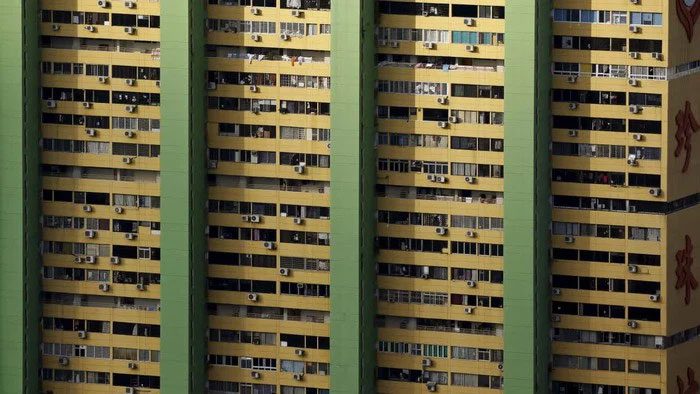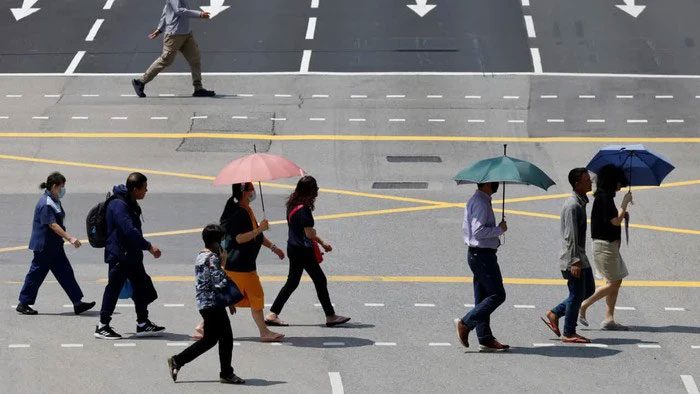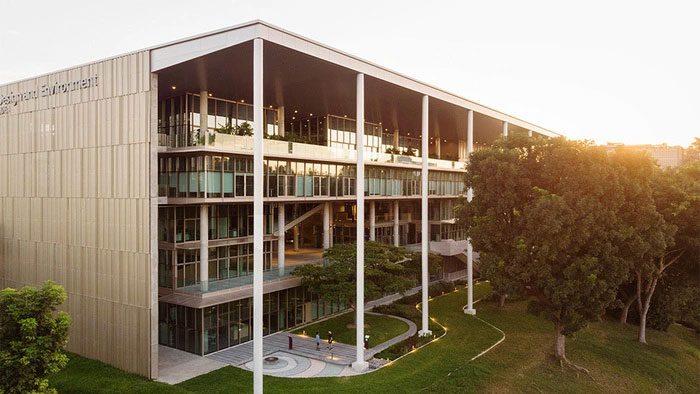“You can’t live without air conditioning in Singapore, not with that heat,” a Singaporean stated.
When temperatures soared to 37 degrees Celsius last month, Singapore resident Chee Kuan Chew saw only one option: cancel all plans and stay indoors, cranking up the air conditioning to stay cool.
The 20-year-old university student lives with his family in a four-bedroom apartment in Ang Mo Kio, a bustling district that drew attention in Singapore when its temperatures hit a 40-year high during the recent heatwave. Fortunately, Chee noted that his home has five air conditioning units—one in each bedroom and the largest in the living room.

Air conditioning units outside an apartment building in Singapore.
“I drank plenty of water, took cold showers, and kept the air conditioning on all weekend. That’s how I manage the heat,” Chee said.
Enjoying the coolness of air conditioning in Singapore is an understandable behavior. Located just over 100 km north of the equator, this island nation is famously hot and humid, with temperatures above 26 degrees Celsius year-round. It also ranks among the highest in the world for air conditioning units per capita, leading Southeast Asia.
Indeed, in this city, air conditioning is a way of life. An office or shopping mall would be hard-pressed to operate without them; 99% of private apartments are equipped with air conditioning, as are most social housing apartments.
The late founding father of Singapore, Lee Kuan Yew, once called air conditioning “the greatest invention of the 20th century” and credited it with helping transform the island from a poor British colony into one of the world’s thriving financial centers, with a top income per capita.

Singapore has a typical hot and humid tropical climate.
However, Singapore’s love for air conditioning comes at a significant cost.
This love leads a country that is already hot—and getting hotter—into what experts describe as “a dangerous vicious cycle.” This is the “Catch-22 paradox” of climate change that all air conditioning-dependent nations must face.
“Catch-22 paradox” is a term coined from the novel of the same name by author Joseph Heller. It refers to a contradictory situation or rule, where two contrasting conditions or requirements create an inescapable and unresolved cycle.
Simply put: The warmer the world gets, the more people turn to air conditioning. And the more they use air conditioning, the warmer the world becomes.
The Paradox of Global Warming
Compared to vehicle emissions and livestock farming, air conditioning often “escapes scrutiny” when most media outlets report on the culprits of global warming. Yet they are a powerful force in accelerating climate change.
The World Economic Forum (WEF) has estimated that—if left unchecked—greenhouse gas emissions related to air conditioning could drive global temperatures up by as much as 0.5 degrees Celsius by the end of this century.
They have a dual impact on global warming. First, like refrigerators, many air conditioning units today use a type of refrigerant called hydrofluorocarbons, or HFCs, which are harmful greenhouse gases.
Second, and perhaps even more concerning, air conditioning units tend to consume large amounts of electricity, generated from burning fossil fuels.
According to the International Energy Agency, air conditioning and fans account for about 10% of total global electricity consumption.

Workers laboring under the scorching sun of the Lion City.
As a nation smaller than New York City, Singapore—with a population of about 5.4 million—only contributes a small fraction of HFCs and electricity consumption that drives global warming.
For instance, even with high per capita usage, its total emissions still cannot compare to Japan and the United States, where about 90% of households use air conditioning, according to WEF.
However, this does not mean Singapore will escape the consequences of a warming world. And as a nation that is already hot and warming quickly, this country has less time than many others before temperatures become unbearable.
According to government data published in 2019, the city has warmed at twice the rate of the rest of the world over the past six decades. Officials warn that daily maximum temperatures could reach as high as 37 degrees Celsius by 2100.
But the rising temperatures in Singapore are not solely due to global warming.
Another contributing factor is the urban heat island effect, where highly urbanized areas experience higher temperatures than their surrounding regions.
This effect is caused by urban structures such as buildings, roads, and vehicles retaining and releasing heat into the environment, particularly at night, and is especially pronounced in densely developed and populated places like Singapore.
According to the U.S. Environmental Protection Agency, this situation is exacerbated by the heat emitted in cities from vehicles, factories, and air conditioning units.
Government Encouragement for Reduced Air Conditioning Usage
The National Environment Agency of Singapore (NEA) has banned the supply of high GWP refrigerants since October last year and stated that it encourages households to use fans instead of air conditioning whenever possible.
This government agency has also advised residents to set timers and keep the temperature no lower than 25 degrees Celsius, as well as to perform regular maintenance to maintain efficiency.
Considering environmental concerns, a local university has built what it calls the country’s first “net-zero energy building”—boasting naturally ventilated open spaces and an “innovative hybrid cooling system that provides 100% pre-cooled fresh air.”
“Net-zero energy” is a term used in engineering and environmental science to refer to the actual amount of energy used after subtracting the energy consumed during production, transportation, and conversion.
Operational since 2019, the SDE 4 six-story building on the campus of the National University of Singapore (NUS) stands as proof that cool comfort “does not have to come at the expense of the environment,” the building’s architects told CNN. Deputy President Heng Chye Kiang said, “We have worked hard to ensure that this will be a net-zero energy building.”

The SDE 4 building, pride of NUS.
Here, ceiling fans are used instead of air conditioning units. Smart sensors measure and manage variables from temperature, humidity, and carbon dioxide to air particulates, light, and sound to “promote reduced energy consumption.”
“We hope it will inspire other buildings and designers to achieve similar results and reduce energy use in the fight against climate change,” the university stated.



















































